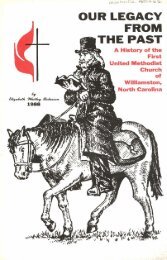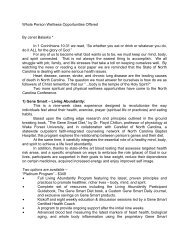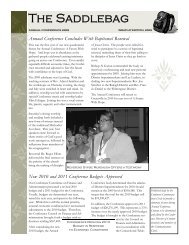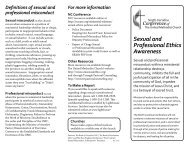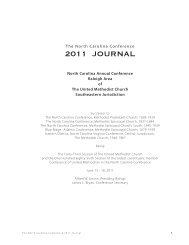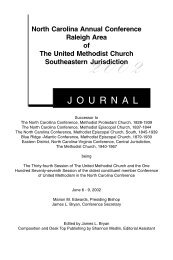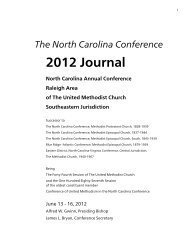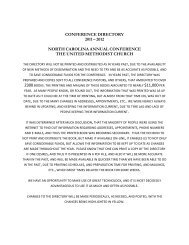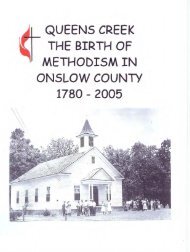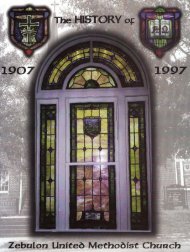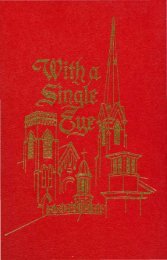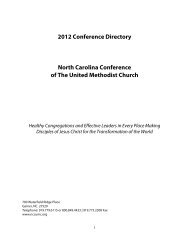Facing Tomorrow, Understanding Yesterday, A History of Orange ...
Facing Tomorrow, Understanding Yesterday, A History of Orange ...
Facing Tomorrow, Understanding Yesterday, A History of Orange ...
Create successful ePaper yourself
Turn your PDF publications into a flip-book with our unique Google optimized e-Paper software.
The Appearance <strong>of</strong> Methodism in the<br />
American Colonies<br />
Methodism began in 1729 as a reform movement within the Church <strong>of</strong><br />
England when John Wesley and his brother Charles found the established<br />
church unable to provide believers with a satisfying spiritual<br />
experience.The faith that emerged from meetings with Oxford Universitystudents<br />
placed a great emphasis on a believer's inner feelings about<br />
God.Although Methodism, as it soon was called, accepted the basic<br />
tenets<strong>of</strong>the Anglican faith, those persons who followed John Wesley, the<br />
recognizedleader <strong>of</strong> this evangelical movement, were convinced that the<br />
HolySpirit had a direct influence on a believer's life, and were confident<br />
that individuals could know that they were children <strong>of</strong> God.<br />
Wesley originally planned to keep his growing Methodist societies<br />
withinthe Church <strong>of</strong> England. Opposition to many <strong>of</strong> his basic teachings,<br />
however, soon caused changes in plans that ultimately strongly influenced<br />
the way in which the church would grow in America. Wesley's<br />
followers,for instance, were refused access to Anglican facilities for<br />
meetingsand were forced to hold their meetings out-<strong>of</strong>-doors. Thus, field<br />
preaching became common in Methodist practice; in the United States,<br />
such field preaching would assume its most popular form in camp<br />
meetings. Methodist chapels developed in England to serve those who<br />
wished to follow the Wesleys' teachings, and because John Wesley<br />
refusedto sever ties with the Church <strong>of</strong>England and the Anglicans would<br />
notordain clergy to serve the Methodists, these chapels <strong>of</strong>ten were led by<br />
laymen.Many <strong>of</strong> these lay leaders were licensed by the Methodists to<br />
serve as local preachers who taught in their own neighborhoods on<br />
Sundays and then held regular jobs during the week. In addition, the<br />
circumstances led to the development <strong>of</strong>traveling preachers who gave all<br />
<strong>of</strong>their time to spreading Methodism throughout the country. Both lay<br />
preachers and circuit riders would become well known in the development<strong>of</strong><br />
Methodism in the United States.<br />
As Methodism developed in England, leaders <strong>of</strong> the Church <strong>of</strong><br />
Englandslowly changed their attitudes toward the evangelistic societies.<br />
Anglicanclergymen allowed Methodists to occupy their pulpits, and the<br />
church itself was revitalized as the Wesleyan teachings spread through<br />
itsranks. Neither John nor Charles Wesley considered their movement<br />
as separate from the Mother Church. They advised against holding<br />
Methodist meetings to compete with Anglican services and urged Methodists<br />
to receive sacraments only from ordained Anglican clergymen.<br />
These stands, however, would cause significant problems for Methodism<br />
inthe British colonies.<br />
In fact, Methodism came to the colonies without John Wesley's<br />
knowledge or approval. Two men who had served as local preachers in<br />
Ireland, Robert Strawbridge and Philip Emory, settled in different parts<br />
<strong>of</strong>the colonies and began spreading Methodist beliefs. The enthusiasm<br />
<strong>of</strong>these two men, rather than an express order from John Wesley, led to<br />
the start <strong>of</strong> Methodist societies in the American colonies. They were<br />
joinedby Captain Thomas Webb, a British <strong>of</strong>ficer assigned to the colonies<br />
by the army. By 1768, Methodist societies had appeared in New York,<br />
NewJersey, Pennsylvania, and Maryland.<br />
When] ohn Wesley heard <strong>of</strong>these spontaneous activities, he sent two<br />
English preachers, Richard Boardman and Joseph Pilmore, to spearhead<br />
Methodist work in the colonies. Although they arrived in 1769, the man<br />
who had the greatest impact on American Methodism, Francis Asbury,<br />
did not arrive until 1771. Asbury's commitment to spreading Wesleyan<br />
theology led him to travel up and down the Atlantic coast to preach the<br />
FACING TOMORROW, UNDERSTANDING YESTERDAY 1<br />
John Wesley<br />
Photo by permission <strong>of</strong> Methodist Library,<br />
United Methodist Church Archives and<br />
<strong>History</strong> Center, Drew University, Madison<br />
New Jersey<br />
Charles Wesley<br />
Photo by permission <strong>of</strong> Methodist Library,<br />
United Methodist Church Archives and<br />
<strong>History</strong> Center, Drew University, Madison<br />
New Jersey



